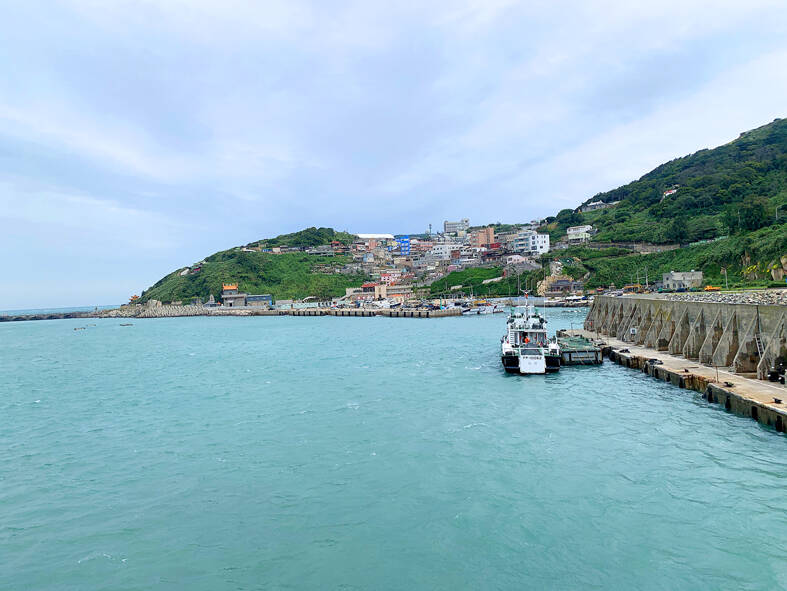The legislature’s Transportation Committee yesterday passed a motion asking the National Communications Commission (NCC) and the Ministry of Digital Affairs to increase capacity to maintain undersea cables after two connections between Taiwan proper and Lienchiang County were broken, allegedly by Chinese vessels.
The motion, which was proposed by Chinese Nationalist Party (KMT) Legislator Chen Hsueh-sheng (陳雪生) and seconded by three other lawmakers, says that the two incidents on Feb. 2 and Feb. 8 severely disrupted communications for residents of the outlying islands.
Although Chunghwa Telecom Co (中華電信) has since last month expanded the bandwidth of a microwave signaling system to maintain telephone and Internet services in the county, it is only enough to sustain basic services, the motion says.

Photo: CNA
Limited bandwidth in the microwave signaling system made it difficult for people to access mobile and broadband Internet services, and Chunghwa Telecom’s multimedia-on-demand services, it says.
“Although Chunghwa Telecom has been trying to book an international cable maintenance ship to repair the broken cables, the earliest ship cannot arrive until April 20,” the motion says.
“Taiwan has a strong manufacturing capability for information and communications equipment, and could become a key undersea cable hub with its geographical and technological advantages,” it says. “The resilience of communication networks must be bolstered through multiple transmission media, and the capability to maintain and swiftly repair key facilities.”
“The NCC and the ministry should study the possibility of expanding the capabilities of local operators to maintain undersea cables,” it says.
Separately, the NCC proposed an amendment to the Telecommunications Management Act (電信管理法) that would mandate penalties for damaging undersea cables.
It must consult with ministry officials over the wording of the amendment and the amount of the fines, it said.
Article 72 of the act stipulates that damaging “submarine cable landing stations, international switchboard centers and satellite communications centers” is penalizable by three to 10 years in prison, NCC Deputy Chairman and spokesman Wong Po-tsung (翁柏宗) told a news conference in Taipei.
Those who damage such facilities due to negligence would be sentenced to no more than six months in prison or a fine of NT$200,000, Wong said.
However, the rules do not apply to undersea cables, he said.
NCC Chairman Chen Yaw-shyang (陳耀祥) pledged to toughen sanctions for those who damage undersea cables deliberately or negligently, by proposing an amendment to the act within one month.
The commission proposed to add an article 72-1 to the act stipulating penalties for breaking international and domestic submarine cables, Wong said, adding that the fines and other penalties would be increased.
Separately, the Financial Times reported that China is attempting to impede subsea Internet cable laying and maintenance in the South China Sea within its 12 nautical mile (22.2km) seabed territory by delaying permit approvals and lengthening administrative processes.
“China is attempting to exert more control over undersea activities in its region, in part to prevent US surveillance systems from being installed as part of undersea cable deployment,” Bryan Clark, a former US submarine officer and senior US Navy official, and now a senior fellow at the Hudson Institute think tank, said in the report.
Chinese authorities have made the process to obtain permits long and onerous, three industry executives with knowledge of the situation said in the report.
Several industry sources said that China’s policing of its waters — including maritime areas marked on maps by the disputed “nine-dash line” — is a response to Beijing being excluded from international projects and fears that companies could use cables as a front for espionage, the Financial Times reported.
To avoid a deadlock over permits, cable consortiums were seeking new routes that circumvent Chinese waters, the sources said.
Avoiding the South China Sea meant greater expenses, as shallow waters near Borneo require extra layers of protection for the fiber cables, they said.
Additional reporting by Jake Chung

The CIA has a message for Chinese government officials worried about their place in Chinese President Xi Jinping’s (習近平) government: Come work with us. The agency released two Mandarin-language videos on social media on Thursday inviting disgruntled officials to contact the CIA. The recruitment videos posted on YouTube and X racked up more than 5 million views combined in their first day. The outreach comes as CIA Director John Ratcliffe has vowed to boost the agency’s use of intelligence from human sources and its focus on China, which has recently targeted US officials with its own espionage operations. The videos are “aimed at

STEADFAST FRIEND: The bills encourage increased Taiwan-US engagement and address China’s distortion of UN Resolution 2758 to isolate Taiwan internationally The Presidential Office yesterday thanked the US House of Representatives for unanimously passing two Taiwan-related bills highlighting its solid support for Taiwan’s democracy and global participation, and for deepening bilateral relations. One of the bills, the Taiwan Assurance Implementation Act, requires the US Department of State to periodically review its guidelines for engagement with Taiwan, and report to the US Congress on the guidelines and plans to lift self-imposed limitations on US-Taiwan engagement. The other bill is the Taiwan International Solidarity Act, which clarifies that UN Resolution 2758 does not address the issue of the representation of Taiwan or its people in

DEFENDING DEMOCRACY: Taiwan shares the same values as those that fought in WWII, and nations must unite to halt the expansion of a new authoritarian bloc, Lai said The government yesterday held a commemoration ceremony for Victory in Europe (V-E) Day, joining the rest of the world for the first time to mark the anniversary of the end of World War II in Europe. Taiwan honoring V-E Day signifies “our growing connections with the international community,” President William Lai (賴清德) said at a reception in Taipei on the 80th anniversary of V-E Day. One of the major lessons of World War II is that “authoritarianism and aggression lead only to slaughter, tragedy and greater inequality,” Lai said. Even more importantly, the war also taught people that “those who cherish peace cannot

US Indo-Pacific Commander Admiral Samuel Paparo on Friday expressed concern over the rate at which China is diversifying its military exercises, the Financial Times (FT) reported on Saturday. “The rates of change on the depth and breadth of their exercises is the one non-linear effect that I’ve seen in the last year that wakes me up at night or keeps me up at night,” Paparo was quoted by FT as saying while attending the annual Sedona Forum at the McCain Institute in Arizona. Paparo also expressed concern over the speed with which China was expanding its military. While the US